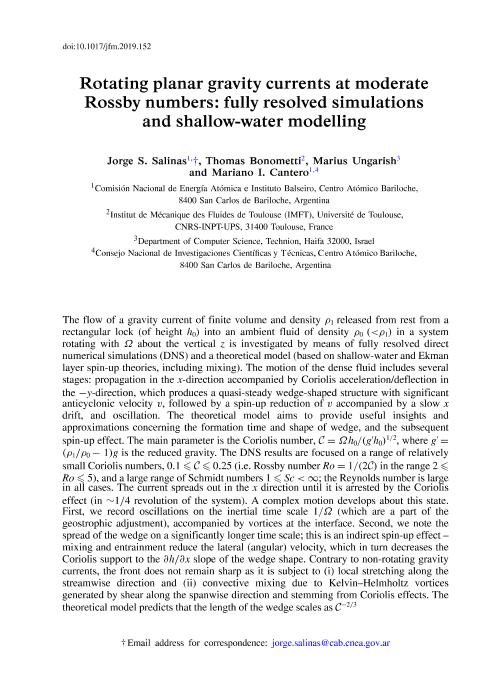Mostrar el registro sencillo del ítem
dc.contributor.author
Salinas, Jorge Sebastián

dc.contributor.author
Bonometti, Thomas
dc.contributor.author
Ungarish, Marius
dc.contributor.author
Cantero, Mariano Ignacio

dc.date.available
2020-10-23T20:36:40Z
dc.date.issued
2019-05
dc.identifier.citation
Salinas, Jorge Sebastián; Bonometti, Thomas; Ungarish, Marius; Cantero, Mariano Ignacio; Rotating planar gravity currents at moderate Rossby numbers: Fully resolved simulations and shallow-water modelling; Cambridge University Press; Journal of Fluid Mechanics; 867; 5-2019; 114-145
dc.identifier.issn
0022-1120
dc.identifier.uri
http://hdl.handle.net/11336/116767
dc.description.abstract
The flow of a gravity current of finite volume and density ρ 1 released from rest from a rectangular lock (of height h 0 ) into an ambient fluid of density ρ 1 (< ρ 1 ) in a system rotating with Ω about the vertical z is investigated by means of fully resolved direct numerical simulations (DNS) and a theoretical model (based on shallow-water and Ekman layer spin-up theories, including mixing). The motion of the dense fluid includes several stages: propagation in the x-direction accompanied by Coriolis acceleration/deflection in the -y-direction, which produces a quasi-steady wedge-shaped structure with significant anticyclonic velocity v, followed by a spin-up reduction of v accompanied by a slow x drift, and oscillation. The theoretical model aims to provide useful insights and approximations concerning the formation time and shape of wedge, and the subsequent spin-up effect. The main parameter is the Coriolis number, C = Ωh 0 /(g′h 0 ) 1/2 , where g′ =(ρ 1 /ρ 0 -1)g is the reduced gravity. The DNS results are focused on a range of relatively small Coriolis numbers, 0.1 ≤ C ≤ 0.25 (i.e. Rossby number Ro = 1=(2C) in the range 2 ≤ Ro ≤ 5), and a large range of Schmidt numbers 1≤Sc<∞; the Reynolds number is large in all cases. The current spreads out in the x direction until it is arrested by the Coriolis effect (in ∼1/4 revolution of the system). A complex motion develops about this state. First, we record oscillations on the inertial time scale 1/Ω (which are a part of the geostrophic adjustment), accompanied by vortices at the interface. Second, we note the spread of the wedge on a significantly longer time scale; this is an indirect spin-up effect - mixing and entrainment reduce the lateral (angular) velocity, which in turn decreases the Coriolis support to the ∂h/∂x slope of the wedge shape. Contrary to non-rotating gravity currents, the front does not remain sharp as it is subject to (i) local stretching along the streamwise direction and (ii) convective mixing due to Kelvin-Helmholtz vortices generated by shear along the spanwise direction and stemming from Coriolis effects. The theoretical model predicts that the length of the wedge scales as C -2/3 (in contrast to the Rossby radius ∈1/C which is relevant for large C; and in contrast to C -1/2 for the axisymmetric lens).
dc.format
application/pdf
dc.language.iso
eng
dc.publisher
Cambridge University Press

dc.relation
Corregido en https://doi.org/10.1017/jfm.2020.167
dc.rights
info:eu-repo/semantics/openAccess
dc.rights.uri
https://creativecommons.org/licenses/by-nc-nd/2.5/ar/
dc.subject
GRAVITY CURRENTS
dc.subject
ROTATING FLOWS
dc.subject.classification
Ingeniería Mecánica

dc.subject.classification
Ingeniería Mecánica

dc.subject.classification
INGENIERÍAS Y TECNOLOGÍAS

dc.title
Rotating planar gravity currents at moderate Rossby numbers: Fully resolved simulations and shallow-water modelling
dc.type
info:eu-repo/semantics/article
dc.type
info:ar-repo/semantics/artículo
dc.type
info:eu-repo/semantics/publishedVersion
dc.date.updated
2020-10-07T13:57:58Z
dc.journal.volume
867
dc.journal.pagination
114-145
dc.journal.pais
Reino Unido

dc.journal.ciudad
Cambridge
dc.description.fil
Fil: Salinas, Jorge Sebastián. Consejo Nacional de Investigaciones Científicas y Técnicas. Centro Científico Tecnológico Conicet - Patagonia Norte; Argentina. Comisión Nacional de Energía Atómica. Centro Atómico Bariloche; Argentina. Comisión Nacional de Energía Atómica. Gerencia del Área de Energía Nuclear. Instituto Balseiro; Argentina
dc.description.fil
Fil: Bonometti, Thomas. Centre National de la Recherche Scientifique; Francia. Université de Toulouse. Institut de Mécanique des Fluides de Toulouse; Francia
dc.description.fil
Fil: Ungarish, Marius. Technion - Israel Institute of Technology; Israel
dc.description.fil
Fil: Cantero, Mariano Ignacio. Consejo Nacional de Investigaciones Científicas y Técnicas. Centro Científico Tecnológico Conicet - Patagonia Norte; Argentina. Comisión Nacional de Energía Atómica. Centro Atómico Bariloche; Argentina. Comisión Nacional de Energía Atómica. Gerencia del Área de Energía Nuclear. Instituto Balseiro; Argentina
dc.journal.title
Journal of Fluid Mechanics

dc.relation.alternativeid
info:eu-repo/semantics/altIdentifier/doi/http://dx.doi.org/10.1017/jfm.2019.152
dc.relation.alternativeid
info:eu-repo/semantics/altIdentifier/url/https://www.cambridge.org/core/journals/journal-of-fluid-mechanics/article/rotating-planar-gravity-currents-at-moderate-rossby-numbers-fully-resolved-simulations-and-shallowwater-modelling/D6CAA27FBF035F6199E9C0C19F8F3706
Archivos asociados
